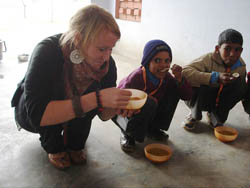Ilse de Jager has recently joined the N2Africa project team at Wageningen University to conduct a literature study on the nutritional benefits of legume consumption at household level. As a nutritionist, she entered a new world of crops and farming. Talking about the uptake of nitrogen already resulted in some confusion, as it was referred to the uptake by the plant and not by the body. But it is exactly these two worlds we need to combine to understand N2Africa’s impact on nutrition. Ilse completed an MSc in human nutrition and health at Wageningen University, with a focus on malnutrition in developing countries. Her past research within the TELFUN program, carried out as a master thesis in India, focussed on the combined effect of consuming a mungbean based meal (which is relatively high in iron) and guava (which is high in vitamin C) on iron status and nutritional indicators of rural Indian schoolchildren. Ilse’s study will focus on the following research questions:
- What are the nutritional values of cowpea, groundnut, soybean, common bean, chickpea and pigeon pea?
- What is the significance of the nutrients present in legumes for the human body, and how do they affect the health of humans?
- Which factors influence the bioavailability of the nutrients (antinutrients present in legumes, preparation methods, combination of foods consumed, nutritional status)? How do they influence the bioavailability and to what extent?
- Is there evidence that increased nutrition security at household level, increases labour productivity?
- Which indicators can be measured to show the effect of the activities of N2Africa on nutrition security at household level?
| Photo: Ilse eating mungbean based meal together with the Indian schoolchildren in the TELFUN project in India, carrying out her masters thesis |
 |
Preliminary results indicate that, as we all know, legumes are an important source of protein in resource-poor settings, particularly among plant-based diets. The protein content of legumes is generally between 20% and 30% of energy. A serving of legumes (about 90 grams) provides about 15% of the recommended daily allowance (RDA) for protein for a 70-kg adult. Although legumes are recognized as being high in protein, the quality of bean protein is often underestimated. Two factors influence protein quality: the protein’s digestibility and its amino acid composition. Proteins must be digested before they can provide amino acids. This depends on the protein’s source and other foods eaten with it. Animal protein is highly digestible (90 to 99 percent) but plant proteins are less digestible (70 to 90 percent for most). The protein quality of most beans is reasonably good, although their overall value is reduced somewhat by their low digestibility. When people are deprived of protein, energy or both, the result is protein-energy malnutrition (PEM) and leads to the syndromes of marasmus (chronic protein-energy malnutrition), kwashiorkor (acute protein-energy malnutrition, also known as ‘hunger belly’) or a mixture of both. PEM most often strikes early in childhood and is one of the most prevalent and devastating forms of malnutrition in the world, afflicting one of every four children worldwide. Besides an excellent source of protein, legumes are also an important source of minerals and vitamins. Ilse will further research the significance of these nutrients for the human body (iron, zinc, vitamins B) and the quality of the nutrients in legumes. For example, the bioavailability of these minerals and vitamins are limited by the presence of antinutrients (compounds that interfere with the absorption of nutrients) in legumes, such as phytate. However, traditional household food-processing and preparation methods can enhance the bioavailability by decreasing the content of antinutrients and increasing the content of compounds that improve bioavailability.
Ilse de Jager
